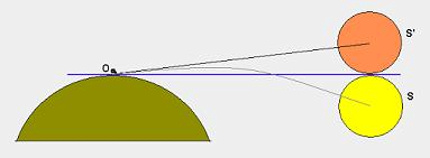
The March 2020 equinox – the Northern Hemisphere’s spring or vernal equinox and the Southern Hemisphere’s autumn equinox – falls on Friday, March 20, at 03:50 UTC (11:50 p.m. EDT; translate UTC to your time). The word equinox means equal night, and it’s often said that days and nights are equal lengths twice a year, at the March and September equinoxes, for everyone worldwide. Is it true?
Does everyone receive 12 hours of day and 12 hours of night at the equinoxes? Not exactly. There’s actually more day than night on the day of an equinox. There are two reasons why.
1. The sun is a disk, not a point. Watch any sunset, and you know the sun appears in Earth’s sky as a disk.
It’s not pointlike, as stars are, and yet – by definition – most almanacs regard sunrise as when the leading edge of the sun first touches the eastern horizon. They define sunset as when the sun’s trailing edge finally touches the western horizon.
This in itself provides an extra 2 1/2 to 3 minutes of daylight at mid-temperate latitudes.

Atmospheric refraction raises the sun about 1/2 degree upward in our sky at both sunrise and sunset. This advances the time of actual sunrise, while delaying the time of actual sunset. The result is several minutes of extra daylight, not just at an equinox, but every day. Image via Wikipedia.
2. Atmospheric refraction. The Earth’s atmosphere acts like a lens or prism, uplifting the sun about 0.5 degrees from its true geometrical position whenever the sun nears the horizon. Coincidentally, the sun’s angular diameter spans about 0.5 degrees, as well.
In other words, when you see the sun on the horizon, it’s actually just below the horizon geometrically.
What does atmospheric refraction mean for the length of daylight? It advances the sunrise and delays the sunset, adding nearly another six minutes of daylight at mid-temperate latitudes. Hence, more daylight than night at the equinox.
Astronomical almanacs usually don’t give sunrise or sunset times to the second. That’s because atmospheric refraction varies somewhat, depending on air temperature, humidity and barometric pressure. Lower temperature, higher humidity and higher barometric pressure all increase atmospheric refraction.
On the day of the equinox, the center of the sun would set about 12 hours after rising – given a level horizon, as at sea, and no atmospheric refraction.
Bottom line: There’s slightly more day than night on the day of an equinox. That’s because the sun is a disk, not a point of light, and because Earth’s atmosphere refracts (bends) sunlight. These factors add up to provide an additional 8 or so minutes of daylight on the day of the equinox at mid-temperate latitudes.
Source:
https://earthsky.org/astronomy-essentials/are-day-and-night-equal-at-the-march-equinox

